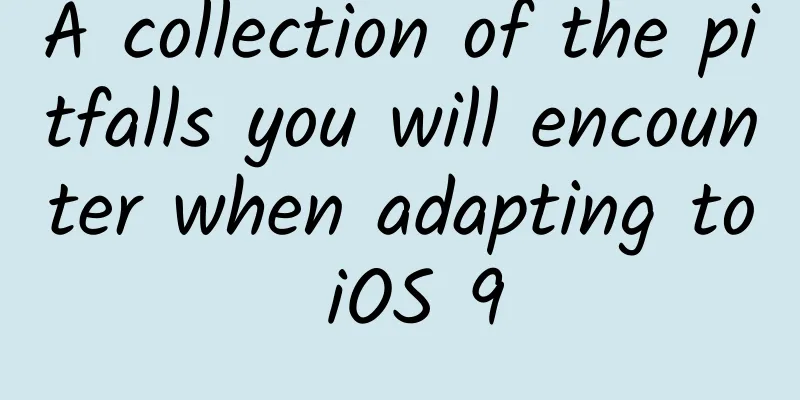A collection of the pitfalls you will encounter when adapting to iOS 9

|
This article mainly talks about some pitfalls in iOS9 adaptation. If you just want to understand the new features of iOS9, you can read the new features of iOS 9 SDK that developers need to know. In the early morning of September 17, Apple pushed the official version of iOS9 to users. As users continued to upgrade to iOS9, a series of problems gradually emerged. The author was also busy adapting the App he maintained. Most of the pitfalls described in this article are personal experiences. iOS9 makes all HTTP use HTTPS by default, and the original HTTP protocol transmission is changed to TLS1.2 protocol for transmission. The direct result is that when the App sends a request, it pops up that the network cannot be connected. The solution is to add the following node in the project's info.plist file: NSAppTransportSecurity - NSAllowsArbitraryLoads This subnode means: Is arbitrary loading allowed? ! If it is set to YES, AppTransportSecurity will be disabled and user-defined settings will be used instead, which solves this problem. It is said above that Apple has restricted the HTTP protocol, but it does not mean that all HTTPS can be fully adapted to iOS9. For example, load an https web page from the webView in the app. Create a new project and write a few lines of code to load the web page.
The url in the middle is the https address we want to load. Try it with https://baidu.com/ and https://github.com/ respectively, the results are different The github webpage can be opened, but the Baidu webpage cannot be opened. A line of log is printed below
The reason is that Apple's official information says that it must be based on TLS 1.2 version protocol. Then the encryption algorithm of the certificate must reach SHA256 or higher RSA key or ECC key. If it does not meet the requirements, the request will be interrupted and nil will be returned. You can directly view the encryption algorithm of this website in the browser. First click the green lock and then click the certificate information. As can be seen from the two pictures on the right, GitHub's SHA-256 with RSA encryption meets Apple's requirements, so it can be displayed. For Baidu, you can configure it in info.plist as follows. If there are many websites referencing it, you should configure it for each website. NSAppTransportSecurity, NSExceptionDomains, NSIncludesSubdomains, NSExceptionRequiresForwardSecrecy, NSExceptionAllowInsecureHTTPLoads are written below for easy copying. The ForwardSecrecy is understood as an advanced password protection algorithm, which is written in the official data. There are 11 types in total. After the configuration is completed, Baidu can access it.
Bitcode should be understood as a transitional code compiled into a program, and then Apple compiles this transitional code into an executable program. Bitcode also allows Apple to re-optimize the binary file of our program at a later stage, which is similar to the idea of App slimming. The following error may occur when using the xcode7 compiler to compile a project that was previously working properly.
The reason for the problem is that some third-party libraries do not support bitcode yet. Either we wait for the library developer to upgrade this function and then update the library, or we disable this bitcode. The way to disable it is to find the following configuration and select NO. (Bitcode is YES by default in iOS, and bitcodes cannot be changed in watchOS and must be YES.)
This item is only relevant to enterprise-level applications or inhose, and has nothing to do with applications on the AppStore channel. In iOS8, a window will pop up asking if you need to trust the app, but in iOS9, it is directly prohibited. If you really want to trust the app, you need to manually open it. It is similar to the Mac system downloading a dmg from an unknown developer and you can't open it directly, so you have to go to the security and privacy of the system preferences to manually open it. The following picture shows iOS8 on the left and iOS9 on the right. Users need to go to Settings---》General---》Description File to add trust themselves. There are two ways to deal with this problem: 1. Inform employees in advance not to upgrade to iOS 9 for the time being 2. Most of the applications are enterprise-level applications used by company employees, so send a guidance email to the group.
In iOS8, the font is Helvetica, and the Chinese font is a bit similar to "Huawen Xihei". It's just that Apple phones have their own rendering, so it may look more beautiful than ordinary Huawen Xihei. In iOS9, the Chinese system font has become "Pingfang" designed specifically for China, which is a bit similar to a word font "Youyuan". The font has a slight bold effect, and the most important thing is that the font spacing has become larger! Therefore, many labels that originally have a fixed width may show “...”. The two pictures above can also intuitively show the changes of the same interface and the same label. Therefore, in order to avoid errors in the interface display, even if the text is of fixed length, it is still recommended to use sizetofit or iOS round up ceilf() or calculate in advance
The URL scheme is generally used in scenarios where the application has the function of sharing or jumping to other platforms for authorization, and then jumping back after sharing or authorization. There are not too many restrictions in iOS 8, but iOS 9 requires you to whitelist the URL scheme you want to call externally before you can complete the jump. If iOS9 is not adapted, the following error will be reported
The specific solution is to set the LSApplicationQueriesSchemes type to an array in info.plist and add all the schemes you use below
Fortunately, this is just a warning. If you ignore it, there will be no problem.
In the past, in order to be able to control the style of the top statusbar in real time, we might like to use
But before doing this, you need to add the View controller-based status bar appearance BOOL value to NO in info.plist, which means that the controller is not allowed to control the status bar, and use UIApplication to control it. However, this method is not recommended in iOS9. We recommend that you set the BOOL value to YES and use the controller method to manage the status bar.
Clicking into the header file can verify what you just said:
If the following error is reported during runtime, it means that your didFinishLaunchingWithOptions is not written correctly
iOS9 does not allow the window's rootViewController to be set after didFinishLaunchingWithOptions is finished. Maybe the xcode7 compiler itself does not support it. The solution is of course to initialize a value first, and then assign it to replace it.
Although the official version of iOS9 has been pushed, the App still feels more laggy when using iOS9. The laggy display is most obvious when dragging the tableView. And there was a bug before. When the project was compiled with xcode7, the tableView refresh had problems. [tableView reloadData] was invalid. There was a row of cells that had been changed but could not be refreshed. It seems that this method may conflict with some newly added features. It is speculated that the reloadData operation may be postponed to the next RunLoop execution and finally fail. The solution is to comment [tableView reloadData] and use partial refresh instead, and the problem is solved.
If you are not seeing this article on Dong Boran’s Blog, please click here to view the original text. I have encountered these problems for the time being. I feel that the emergence of iOS9 has made all iOS developers nervous. I hope that Apple's drastic changes and unique style will continue to develop and will not cause conflicts with the government, and then the company will go bankrupt and developers will lose their jobs. Maybe I am overthinking. I hope that all iOS can be adapted and bugs fixed in time, and all problems will be solved when the next version is launched. |
<<: Android source code, imitating Dianping pull-down animation
>>: 160,000 WeChat self-media, the total number of readers dropped by 1.7 billion in the past month
Recommend
How do ocean giants find tiny prey?
© The Marine Mammal Center Leviathan Press: The N...
What are the key points to consider in a good event planning proposal?
This article will share ideas for event planning ...
Xpeng Motors acquires Didi’s smart car business for RMB 5.8 billion. He Xiaopeng expresses his feelings about coincidence and opportunity on Weibo
Xpeng Inc. issued an announcement on the Hong Kon...
"Strong Mentality Training Techniques" training chapter, achieve dimensionality reduction in one week, and build a strong heart in one year
Course Contents: Section 01. Introduction - How t...
Attack, defense, and speed are all bad. How did the koala survive?
Koalas, also known as koala bears, are cute mamma...
How did LeTV, the much-questioned "story king", succeed in becoming an Internet TV company?
The press conference on September 19, 2012 was th...
How much is the market price for a pound of bull whip? How much does a pound of bull whip cost now?
Influenced by traditional Chinese culture, people...
Ten principles for good API design
Every software developer uses APIs. "Good&qu...
After the release of 2499 yuan MX4 Pro, Meizu's target is no longer just Xiaomi
On November 19, Meizu's second major new prod...
How to play with Tik Tok’s recommendation rules?
How to create a hit on Douyin? What are the six m...
How to deal with plural nouns in iOS project internationalization
The way to handle plural nouns in the internation...
APP operation: Talk about why you shouldn’t use money to incentivize user contributions!
The important role of operations is to establish ...
Insights | Three abilities a person needs
Famous Artists Gallery | Chen Banding, also known...
The latest list of sealed-off communities in Shenyang in 2022: Which specific communities need to be quarantined? Attached is the latest news!
Recently, new cases have appeared in some areas o...









